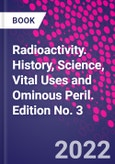Through multiple worked examples, the book answers many questions for the student, teacher and practitioner as to the origins, properties and practical applications of radioactivity in fields such as medicine, biological and environmental research, industry, safe nuclear power free of greenhouse gases and nuclear fusion.
Ratings and Reviews of Previous Editions:
CHOICE Magazine, July 2008: "This work provides an overview of the many interesting aspects of the science of radioactive decays, including in-depth chapters that offer reminiscences on the history and important personalities of the field...This book can be useful as supplemental reading or as a reference when developing course material for nuclear physics, nuclear engineering, or health physics lectures. Special attention?has been given to a chapter on the role radioactivity plays in everyday?life applications...Generally the book is well produced and will be a valuable resource...Many lectures can be lightened up by including material from this work. Summing up: RECOMMENDED. Upper division undergraduates through professionals; technical program students." U. Greife, Colorado School of Mines, USA
"I found the biographical accounts of the various stalwarts of Physics inspirational. Most of them, if not all, had to overcome economic hardships or p[ersonal tragedies or had to do their groundbreaking?work in the face of tyranny and war. The biographies also highlighted the high standards of moral convictions that the scientists had as they realized the grave implications of some of their work and the potential threats to humanity. This ought to inspire and motivate young men and women aspiring to be physicists. Even people who have been in the field for a while should find your book re-energizing. It certainly had that effect on me."
-- Dr. Ramkumar Venkataraman, Canberra Industries, Inc.
Table of Contents
Prologue: Radioactivity/Nuclear Technology and our Well-beingPart 1. History of Discovery
1. Birth of Modern Physics: From the Discovery of Radioactivity to the Discovery of the Proton, Electron and Atomic Nucleus
2. Birth of Quantum Physics: From Planck's Quantum to Einstein's Photon, de Broglie's Wave-Particle Duality and Stern and Gerlach's Electron Spin States
3. Revelations in Nuclear Decay Processes: From Soddy's Displacement Law to Fermi's Beta Decay
4. Discoveries on the Interaction of Radiation with Matter: From X-ray diffraction to the Compton Effect
5. Era of Cherenkov Radiation Discoveries: From the Discovery of Cherenkov Radiation to the Characterization of the Cherenkov Effect
6. Cosmic Discoveries: From the Discovery of Cosmic Rays to the Component Particles and Properties of the Cosmic Radiation Showers
7. Nuclear Era: From the Discovery of the Neutron to Nuclear Fission, Nuclear Energy and Nuclear Non-proliferation
8. Breakthroughs in Nuclear Properties, Nuclear Stability and Accelerators: From Magic Numbers to Magnetic Resonance, and the Discovery of the Antinucleons
9. Era of Particle Physics and the Role of Fundamental Particles in Beta Decay: From the Discovery of Particles, Advances in our Understanding of Particle Interactions and Beta Decay, and the Structure of Matter
Part 2. Elements of Nuclear and Radiation Physics
10. Basic Concepts and Definitions
11. Alpha Radiation
12. Beta Radiation and Beta Decay
13. Electromagnetic Radiation: Photons
14. Neutron Radiation
15. Atomic Electron Radiation
16. Cosmic Radiation
17. Cherenkov Radiation
18. Radionuclide Decay, Radioactivity Units, and Radionuclide Mass
19. The Atomic Nucleus
Epilogue: The Threat of Nuclear Weapons
Appendix A: Alpha- and Beta-particle/Electron Range-Energy Correlations
Appendix B: Lorentz Transformations







